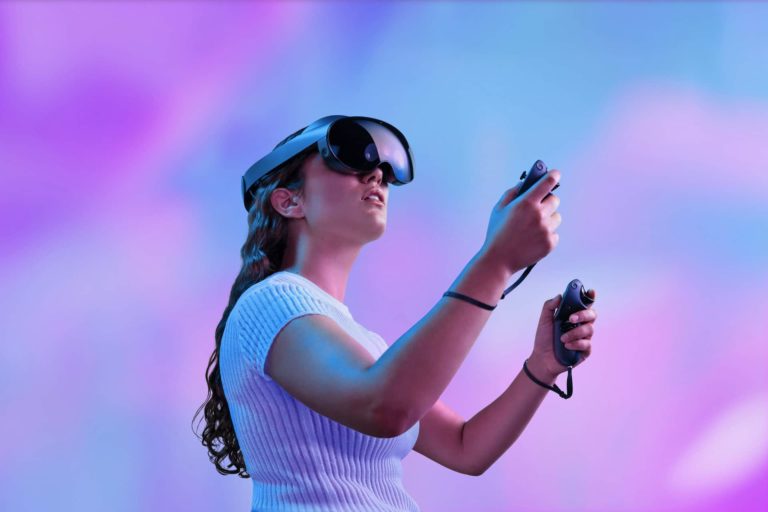
VR can turn a showroom from a physical space into a memorable experience. Strategically implementing this technology enables potential buyers to benefit from enhanced visualization and immersion. Here are seven steps to making it happen.
1. Acquire VR Equipment and Software
VR equipment is fundamental to developing a virtual showroom, so acquiring it should be any company’s first step. Naturally, headsets are essential. Deciding whether to get cardboard, mid-range or high-end models is crucial. Another substantial consideration is deciding whether to secure peripherals like accessories, haptic wearables, steering wheels and controllers. While each device carries an additional expense, they can make the environment more immersive. Generally, the visual enhancements automotive companies aim for will only be as good as their equipment. Combining high-quality headsets, peripherals and software results in the best outcomes.
2. Prioritize Research and Design
Spending an adequate amount of time in research and development can help automotive companies perfect their virtual space and 3D models before they reach consumers. It can also help them improve their design iterations, reducing their reliance on physical prototypes. Engineers, decision-makers and VR professionals can meet in virtual spaces to work together regardless of location. Consequently, they improve collaboration and communication, resulting in a better final product. For instance, Volvo used cameras and sensors to craft virtual simulations that were too dangerous to reproduce in real life — or too improbable — before launching its VR showroom. It tested its 3D model in a range of unique conditions to improve functionality and enhance consumers’ digital interactions. On top of improving the safety and performance of the 3D model’s real-life counterpart, these simulations helped the company compare its virtual environment to the real world. The result was a more lifelike, accurate representation of the vehicle for customers to interact with.
3. Consider a Hybrid Approach
Leveraging VR and augmented reality (AR) to achieve mixed reality is one way to enhance visualization. This hybrid approach lets in-person buyers experience the same benefits as those in the virtual space. Mercedes-Benz — one of the first car companies to set up a VR showroom — did something similar with its AR integration. Potential buyers physically visiting the showroom could scan a QR code to trigger information pop-ups and videos. Enhancing the power of VR through mixed reality is a sound business strategy. After all, experts project its market will have a 43.28% compound annual growth rate from 2022 to 2030. While it would take additional research and development, the outcomes would likely be worth the effort.
4. Develop the Digital Space
Automotive companies can partner with industry experts or hire professionals to streamline development, but they’ll likely have to build their virtual environment from the ground up. This step is among the most critical because it determines if their VR initiative will be successful. The more accurate and realistic their design, the more immersive the customer experience will be. The virtual showroom’s design is crucial because it impacts customers’ perception of the vehicles. Companies should consider how to plan the layout, brand the space and place the 3D models. They’re not bound by the laws of physics, so they should push boundaries. Crucially, enhanced visualization also depends on model development. How lifelike and detailed vehicles look in a virtual space impacts the customer experience. Companies shouldn’t just design the exterior — the engine and interior are just as important. Ideally, the 3D models should be interactive so potential buyers can get the most out of their experience.
5. Elevate the Customer Experience
What can VR offer that the real world can’t? Decision-makers must consider tailoring potential buyers’ interactions with the virtual space to enhance visualization. While standard showings and demonstrations are fine, interactivity, test drives and simulations provide a more memorable buying experience. Automotive companies should consider how their preplanned customer journey aligns with their equipment’s specifications. Most head-mounted displays have a field of view of at least 100 degrees and a minimum frame rate of 60 frames per second, so buyers can usually fully immerse themselves. However, this consideration is still essential.
6. Consider Potential Challenges
Decision-makers should consider how to work around potential challenges early on to enhance vehicle visualization for every potential buyer who enters the showroom. People who have visual impairments or physical disabilities or experience motion sickness should get the same experiences as others. Automotive companies should prepare for these challenges before they happen to protect their reputation and keep their virtual showroom as accessible as possible. After all, these seemingly unlikely scenarios are relatively common. For instance, 22%-80% of VR users report experiencing a kind of motion sickness while wearing a headset. Varying the types of VR headsets available and having accessibility accessories on hand can help in-person potential buyers interact with virtual spaces to the fullest extent possible. Automotive companies should also consider developing helpful tools for customers visiting remotely.
7. Take Advantage of Every Opportunity
VR allows automotive companies to personalize each potential buyer’s experience with a vehicle — unlike in traditional showrooms where the most someone can do is sit in the driver’s seat. They should take full advantage of this opportunity to elevate the customer journey. The opportunities VR presents are as unlimited as the designer’s imagination. Automotive companies should make the most of every opportunity to fully enhance visualization in their virtual showrooms by prioritizing unique experiences. Close-up interactions, feature demonstrations, color customization, and global showings are all beneficial options.
The Showroom of the Future Exists in Virtual Reality
While using VR to develop a virtual environment comes with a high initial cost, the payoff will likely be well worth it. You can reduce your operating costs just by implementing this technology. Additionally, you can benefit from increased reach and brand differentiation. For all these reasons and more, the showroom of the future will exist in VR.
 April Miller is a senior writer at ReHack Magazine and editorial contributor at AR Insider. She specializes in VR/AR, IoT, and business technology. See her work here and follow her @rehackmagazine.
April Miller is a senior writer at ReHack Magazine and editorial contributor at AR Insider. She specializes in VR/AR, IoT, and business technology. See her work here and follow her @rehackmagazine.






